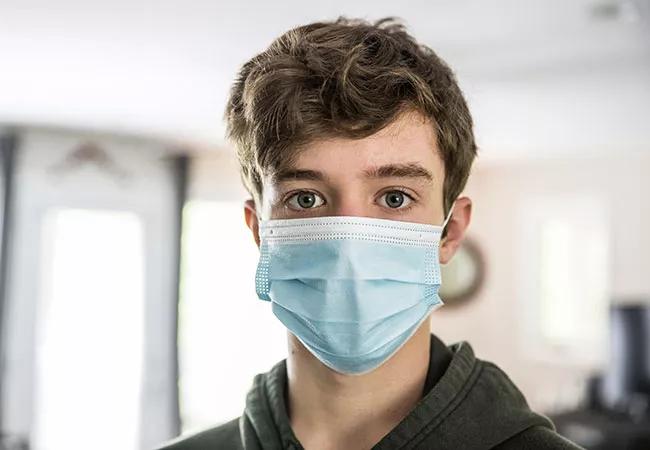Managing anxiety and risk-taking behavior

Case 1: The parents of a teenage girl call for advice from their pediatrician about the appropriateness of social distancing practices to protect from COVID-19 and help with messaging to their child. One parent has breast cancer and is immunocompromised. The family lives in a community where other parents are not being vigilant, and the teenager wants to participate. The teen feels that her parents are being unnecessarily strict in their enforcement of social distancing, and has snuck out to be with her friends on several occasions.
Advertisement
Cleveland Clinic is a non-profit academic medical center. Advertising on our site helps support our mission. We do not endorse non-Cleveland Clinic products or services. Policy
Case 2: A 14-year-old boy with a history of social anxiety and depression presents with concerns about returning to school at the end of the COVID-19 pandemic. Despite spending most of his time in his bedroom, the patient reports insomnia and has begun to lose weight.
For teens and tweens, the COVID-19 pandemic is adding new pressures to a baseline level of moodiness. Disrupted routines, social isolation, tension in the home and worry about world events are likely to compound any pre-existing mental health issues, says Ellen Rome, MD, MPH, a pediatrician and head of the Center for Adolescent Medicine at Cleveland Clinic Children’s.
Pediatricians and health care professionals need to be on the lookout for warning signs of depression and anxiety. At the same time, care providers should expect an increase in risk-taking among teens. “We’re likely to see lots of acting-out behavior during this pandemic,” Dr. Rome says.
Surprisingly, for anxious or introverted teens, current events may actually bring a sense of calm or relief. “People around world have experienced some of the baseline anxiety that they live with day-to-day. For some kids, that’s actually reassuring,” Dr. Rome says. “The world understands them more.”
But many adolescents are struggling. “The extroverts are devastated by the social restrictions we’ve had. Many of them will do everything they can — with risk-taking behaviors, or not socially isolating — to get around social restrictions, which can potentially put their families and loved-ones at risk.”
Advertisement
One solution can be to plan safe ways for teens to engage socially. “That may mean a bike ride or a physically distant bonfire where the parent places the chairs where they need to be.” Parents can talk with teens and tweens about infection and risk in a way that’s developmentally appropriate, she adds.
In some cases, adolescents may sneak out to see friends. When that happens, Rome suggests engaging them in the solution by asking them to suggest their own punishment. They’re more likely to think about the consequences of their actions and may suggest something that’s harsher than the parent would impose.
Screen time and social media use is another mental health concern. “We may see depression and anxiety worsening if social isolation means more time online, especially if unchecked, and especially for kids who’ve become unscheduled and lack adequate sleep,” she says.
Seeing friends and other families socializing while their own family is following stricter distancing rules can be especially hard, she notes. And excessive news consumption, whether via social media, or because family members are monitoring TV or radio throughout the day, can be a stress.
Parents can help by listening to teens talk about their frustration and acknowledging that things are hard. In some cases, teens might have mixed feelings that result in an apparent cognitive dissonance. “They may get that it’s not safe to go out because their mom is immunocompromised, and yet at the same time be completely disappointed and frustrated that they didn’t get to have their high school graduation or a big outing that they had been looking forward to for months.”
Advertisement
As much as isolation may have stressed teens, returning to “normal” will come with its own challenges, especially for teens who are naturally anxious or introverted. “For the very anxious, you can practice,” she says. If kids are worried about going to the store or school, parents and teens can drive by the location to look at it before going inside. They can also engage in role-playing to act out a stressful situation.
Importantly, pediatricians and parents should be on the lookout for signs of depression including changes in eating habits or weight, changes in sleep patterns, or sudden contact with a friend who’s a known troublemaker. “We may only be able to see the tip of the iceberg when the iceberg is depression or anxiety,” Dr. Rome says.
Isolation is a potential warning sign, although a teen hiding in their room isn’t always cause for alarm. “This is a hard one, because in crowded households where everyone is doing their thing from home, a bedroom may become a sanctuary,” she says. “Yet if you have a depressed kid, is the bedroom a dangerous place? Is it a place for self-harm? Is it a place where the kid is stuck in their own head with things getting worse?”
If a teen begins isolating to the point that they’re taking all their meals alone, that can be a sign of disordered eating, or that the family dynamic has become toxic. Any sign of suicidality should prompt an immediate response. “If kids use the words ‘I want to kill myself,’ that’s time for a psychiatrist and a therapist,” she says. “Take those words seriously.”
Advertisement
Advertisement

Patients report improved sense of smell and taste

Clinicians who are accustomed to uncertainty can do well by patients

Unique skin changes can occur after infection or vaccine

Cleveland Clinic analysis suggests that obtaining care for the virus might reveal a previously undiagnosed condition

As the pandemic evolves, rheumatologists must continue to be mindful of most vulnerable patients

Early results suggest positive outcomes from COVID-19 PrEP treatment

Could the virus have caused the condition or triggered previously undiagnosed disease?

Five categories of cutaneous abnormalities are associated with COVID-19